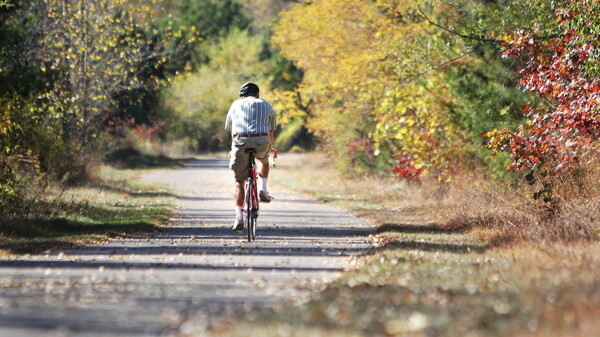Trails On Trial
some local rail trails may be at risk after a recent U.S. Supreme Court ruling
Jeremy Gragert, photos by Andrea Paulseth |

Wisconsin pioneered the concept of turning an abandoned railroad line into a bicycle trail with the Elroy-Sparta Trail in 1965, and since then the Rails to Trails movement has spread across the nation to benefit millions of Americans every day. Abandoned railroad lines that were built and busy during the Chippewa Valley’s lumber boom have been converted into bicycle trails over the past 40 years, and in earnest once the federal government passed the National Trails System Improvement Act in 1988.
Could this case be setting precedent for the future of Rails to Trails, or even jeopardize our own existing trails that meet certain criteria?
But the concept of what is considered “abandoned” is being called into question after an unexpected U.S. Supreme Court ruling last month said that government easements used for rail beds expired when the railroads went out of business. The case, Marvin Brandt Revocable Trust et al. v. United States, went to court when private landowners in Wyoming resisted the conversion of a railway corridor on their property into a section of the Medicine Row Trail, “asserting that the right of way was a mere easement that was extinguished when the railroad abandoned it, so that Brandt now enjoys full title to his land without the burden of the easement.”
Brandt won the case despite losing in two lower courts. Railroads reached Wyoming in the first place due to a long history of the federal government using railroads to fuel westward expansion of the United States, most notably (but not limited to) the 1875 Railroad Right of Way Act. The majority opinion of the court – which by the way was a striking 8-1 – said that the government no longer had a right of way because the 1875 Act only afforded the rail line a temporary easement across the land.
Could this case be setting precedent for the future of Rails to Trails, or even jeopardize our own existing trails that meet certain criteria? Should we be assembling an elite team of railroad history buffs, lawyers, and trail lovers to research the impact of this ruling on our potentially embattled Chippewa River State Trail, the Red Cedar State Trail, and the Old Abe State Trail? (Where is Frank Smoot when you need him?)
Wisconsin Department of Natural Resources state trails coordinator Brigit Brown has already begun working with partners from across the state to begin to address the uncertainty, but it will take some time. “Due to the complicated nature of railroad law and circumstances surrounding each individual rail line, we do not anticipate reaching any concrete conclusions with this preliminary research,” Brown wrote in an email on April 8. She did acknowledge that the state does have some rail corridors that resulted from the 1875 Act at issue in the case.
In a March 13 post on the Bicycle Blog of Wisconsin (wisconsinbikefed.org/blog), Wisconsin Bike Fed deputy director Dave Schlabowske wrote that he learned the following after a bit of research on the State of Wisconsin Office of Commissioner of Railroads website: “Wisconsin has 970 total miles of land-grant railroad lines, of which somewhere around 660 miles are in service with perhaps 220 miles out of service and potentially subject to abandonment. But there are also miles of right-of-way … granted by the U.S. to 13 Wisconsin railroads under the 1875 Railroad Right of Way Act. At the end of 1875, there were 2,566 miles of track in Wisconsin and almost 4,000 miles of track were constructed in Wisconsin after 1875.”
Anyone interested in taking on this history project to research the impact on our local trails could start by using the Rails-to-Trails Conservancy’s list of conditions. If an existing trail meets any one of these conditions, that trail would not be affected: 1) The rail corridor is “railbanked.” 2) The rail corridor was originally acquired by the railroad by a federally granted right-of-way (FGROW) through federal lands before 1875. 3) The railroad originally acquired the corridor from a private landowner. 4) The trail manager owns the land adjacent to the rail corridor. 5) The trail manager owns full title (fee simple) to the corridor. 6) The railroad corridor falls within the original 13 colonies.
Rails-to-Trails Conservancy believes that the vast majority of rail-trails and potential rail-trail projects will not be directly affected by the ruling, and most of those that will be affected are located west of the Mississippi River. Living in the Midwest often puts us in an interesting crossroads of American law, politics, and history. Stay tuned as more research is done about the impact of this ruling on our local trails, or let us know if you do your own.
Jeremy Gragert of the Chippewa Valley Transit Alliance can be reached at jgragert@gmail.com.




















